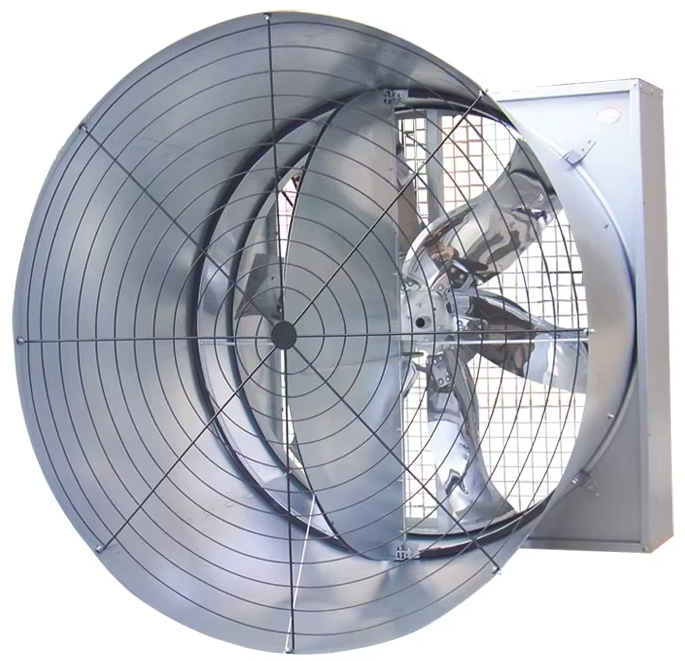Types of Wall Fans and Their Mechanisms
Axial Flow Wall Fans
Wall mounted axial flow fans have become quite common lately because they move air really well throughout homes and businesses alike. What sets them apart is how the blades are positioned along the central axis, creating that straight line airflow pattern most people want. This particular setup works best in places needing steady ventilation all day long, think big open plan offices or industrial warehouses for instance. When looking at different fan options, folks tend to compare these wall units against traditional ceiling models or those old school pedestal fans sitting in corners somewhere. From what we see in the field, axial wall fans generally eat up less power than their counterparts. Some tests show around 20 to 40 percent lower electricity costs over time. So while they definitely blow harder than most alternatives, what really sells them is the money saved month after month on utility bills for property owners and managers.
Exhaust Wall Fans for Ventilation
Wall mounted exhaust fans do wonders for keeping indoor air fresh by getting rid of bad smells and harmful particles. Most folks install them in their kitchen and bathroom areas since proper airflow matters so much there. Some research shows that houses equipped with these fans tend to have about 30% better air quality than those without, which definitely helps everyone breathe easier. The noise level varies quite a bit too, usually somewhere between 40 to 60 decibels. Manufacturers try to strike a good balance between pulling out stale air effectively while not creating too much racket. Plus, these fans don't guzzle electricity either. They generally run on between 40 and 70 watts, so running one all day won't send your electric bill through the roof like some appliances would.
High-Velocity Blower Fans
Blower fans designed for high velocity work best where fast cooling is needed along with focused airflow direction. The way they force air through powerful mechanisms makes them ideal for places like storage facilities and vehicle workshops. Many people who own these fans love how effective they are at cutting down on heat. One customer mentioned that during last summer's brutal heat wave, their fan managed to bring down room temperature within minutes. These types of fans come in small packages too, so moving them around isn't a problem for most folks. According to some market research, around seven out of ten customers living in warmer areas choose high speed cooling options when available, showing just how popular they've become across hotter regions.
Kitchen Ventilation Wall Fans
Wall mounted kitchen fans do wonders at getting rid of smoke and food smells, making the air much better while cooking happens. Most models come equipped with grease catching filters which really matter if someone wants their fan working well over time and meeting basic health codes. The CDC actually mentions how important these fans are for stopping smoke buildup that can lead to all sorts of breathing problems. For best results, installers usually recommend putting the fan somewhere there aren't any cabinets blocking airflow and picking a size that fits the space properly. While no fan is completely foolproof, most modern kitchens rely on these devices to keep things from getting too greasy and smoky, combining practical benefits with everyday usefulness.
Essential Features for Optimal Performance
Space-Saving Mounting Designs
Wall fans need to save space these days, particularly as more people live in smaller spaces than ever before. The best models manage to push plenty of air around without taking up much room at all, which explains why they work so well in tiny bedrooms or apartments where every square inch counts. Most come with different ways to install them too – some stick right onto walls, others go on ceilings. Each setup has its own perks depending on where exactly someone wants cool air flowing through their home. People shopping for these usually care about how something looks just as much as it works. After all, nobody wants an ugly fan sticking out from their wall when there are plenty of sleek models that match modern decor styles while still moving air effectively throughout the room.
Adjustable Oscillation and Tilt
Wall fans with adjustable oscillation and tilt settings really make a difference when it comes to spreading air around a room. People who install these fans tend to love how they can tweak the settings to suit whatever space they're putting them in. Some folks even mention being able to sleep better at night because they can direct cool air exactly where they need it most. The different kinds of oscillation work better for certain situations too. For instance, wider swings might be great for open plan living areas while narrower ones focus air better in smaller spaces or offices where targeted cooling matters more.
Energy-Efficient Motor Technology
Modern wall fans come equipped with energy efficient motors that cut down on power usage when compared to older models. The difference in electricity consumption can really add up over time, which means homeowners save money on their bills while doing something good for the planet too. These new motors last longer than conventional ones and tend to run smoother without all the noise issues people used to complain about. For those looking to upgrade their home cooling system, investing in fans with these advanced motors makes sense both from a financial standpoint and an environmental perspective.
Wall Fan Applications Across Environments
Residential Cooling Solutions
Wall fans make great cooling options for homes, particularly when summer temperatures really crank up. Compared to regular air conditioners that eat through electricity bills, wall mounted fans work much better for saving power and money in the long run. Some tests actually show people save around 30% on cooling expenses just by switching from AC to wall fans. Homeowners who tried them often mention getting that nice refreshing airflow without breaking the bank each month. Families looking to keep things cool without those huge spikes in their electric bill find wall fans to be a smart choice for staying comfortable all summer long.
Commercial Space Ventilation
Good ventilation matters a lot in commercial settings where people work and shop. Wall mounted fans help move air around effectively, something that actually makes a difference in how productive workers stay throughout their shifts. Research indicates that when there's enough fresh air moving through a space, folks tend to focus better and generally feel happier at work. Picking out commercial wall fans isn't just about grabbing whatever fits the budget though. The size and where they go really depends on what kind of business we're talking about here. Cafes often find that directing airflow at certain angles keeps customers comfortable without blowing cold drafts everywhere. Open office layouts typically need multiple fan placements spread across different areas so everyone gets good circulation without standing in front of a blasting breeze all day long.
Industrial Airflow Management
Airflow control matters a lot in places like warehouses and factory floors where workers spend long hours. Wall mounted fans play a big role here, keeping the air moving so temperatures stay manageable. We've seen time and again how proper ventilation cuts down on heat stress risks while also preventing dangerous concentrations of dust particles or chemical vapors from building up over time. These industrial grade fans are built tough too, often featuring stainless steel blades and corrosion resistant housings that stand up to extreme temperatures and constant use. For facility managers looking at long term costs, investing in quality wall fans pays off in reduced maintenance needs and fewer workplace accidents caused by poor air quality.
Selection and Maintenance Guidelines
Assessing Room Size and Airflow Needs
Picking out the right wall fan starts with knowing how big the space is and what kind of air movement we actually need. When figuring out which fan works best for a particular room, folks often turn to things like CFM calculations Cubic Feet per Minute basically tells us how much air moves through the fan each minute. There are gadgets available too anemometers measure actual airflow speed, while online calculators let people plug in their numbers and get recommendations. One thing worth mentioning though bigger isn't always better when it comes to fans. Some folks think that installing a massive fan will automatically mean better results, but that's not always true. Getting familiar with all these factors helps consumers find a fan that keeps them cool without wasting electricity, although sometimes trial and error ends up being part of the process anyway.
Proper Installation Techniques
Getting wall fans installed correctly matters a lot for both safety reasons and how long they'll last. When looking at different kinds of fans, most folks find it makes sense to follow what the manufacturer suggests in their instructions. This helps prevent common mistakes during setup, such as when fans aren't aligned properly which can actually make them work worse or even become dangerous over time. People who try installing these themselves should take stock of what tools are needed versus what professionals typically bring to the job site. The difference between simple installs and complex ones really affects whether someone should tackle it alone or call in help from someone experienced with electrical work.
Routine Cleaning and Safety Checks
Keeping wall fans clean and well maintained makes all the difference when it comes to how long they last and how efficiently they work. Most technicians recommend sticking to a basic maintenance routine that involves dusting off blades at least once a month with something soft like microfiber cloths instead of harsh scrubbing pads that might scratch surfaces. Also important are periodic safety inspections looking for loose wires or connections that could pose fire risks. A quick visual check around the mounting bracket area is good practice too. When homeowners actually take time for this kind of upkeep, their fans tend to run smoother without unexpected breakdowns, which means less hassle and lower energy bills over time in kitchens, bathrooms, or wherever wall fans are installed.

